How Artificial Sweeteners Influence Acid Indigestion - What You Need to Know
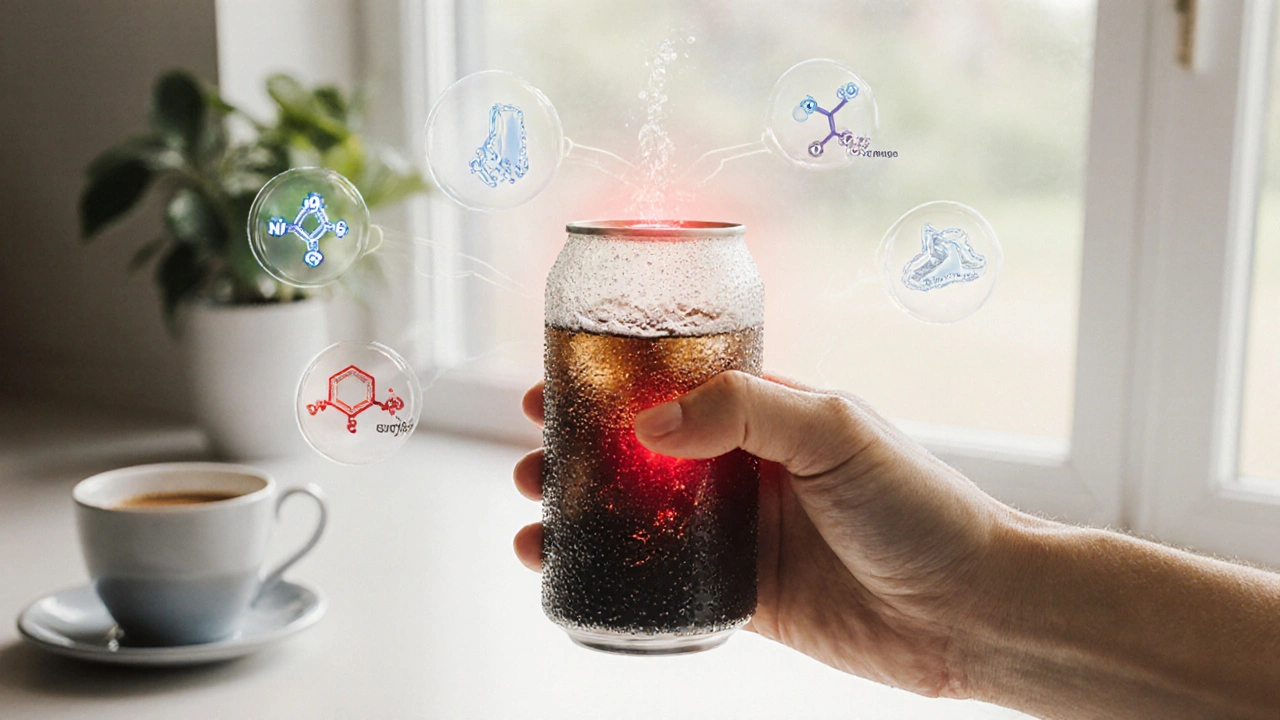
Artificial Sweetener GERD Impact Checker
Aspartame
200x sweeter than sugar
Sucralose
600x sweeter than sugar
Saccharin
300x sweeter than sugar
Stevia
250-300x sweeter than sugar
Ever wonder why a diet soda that’s supposed to be "safe" still leaves you with that burning feeling in your chest? You’re not alone. Many people swap sugar for low‑calorie sweeteners hoping to dodge the calories, only to end up wrestling with acid indigestion, also known as heartburn or GERD. This article breaks down what artificial sweeteners are, how they can trigger stomach acid problems, which sweeteners are the biggest culprits, and what you can actually do to keep the burn at bay.
Key Takeaways
- Artificial sweeteners are chemically diverse; some can relax the lower esophageal sphincter, letting acid flow upward.
- Aspartame and sucralose have the most evidence linking them to increased heartburn episodes.
- Stevia, a natural non‑nutritive sweetener, shows the least impact on acid reflux symptoms.
- Adjusting timing, portion size, and pairing sweeteners with protein can reduce the burn.
- If symptoms persist, consider swapping to natural sweeteners or limiting sweetener use altogether.
What Are Artificial Sweeteners?
Artificial sweeteners are low‑ or zero‑calorie sugar substitutes created through chemical synthesis. They mimic the sweetness of sucrose many times over-Aspartame is about 200 times sweeter, sucralose 600 times, and saccharin roughly 300 times-so only a pinch is needed to sweeten foods and drinks. Because they deliver sweetness without the glucose spike, they’re popular in diet sodas, sugar‑free desserts, and “light” yogurts.
While the term “artificial” suggests something man‑made and potentially unsafe, regulatory bodies in Australia, the U.S., and the EU have approved several of these compounds after extensive toxicology testing. Still, “approved” doesn’t equal “harmless for everyone,” especially when it comes to the delicate balance of stomach acid and the lower esophageal sphincter (LES).
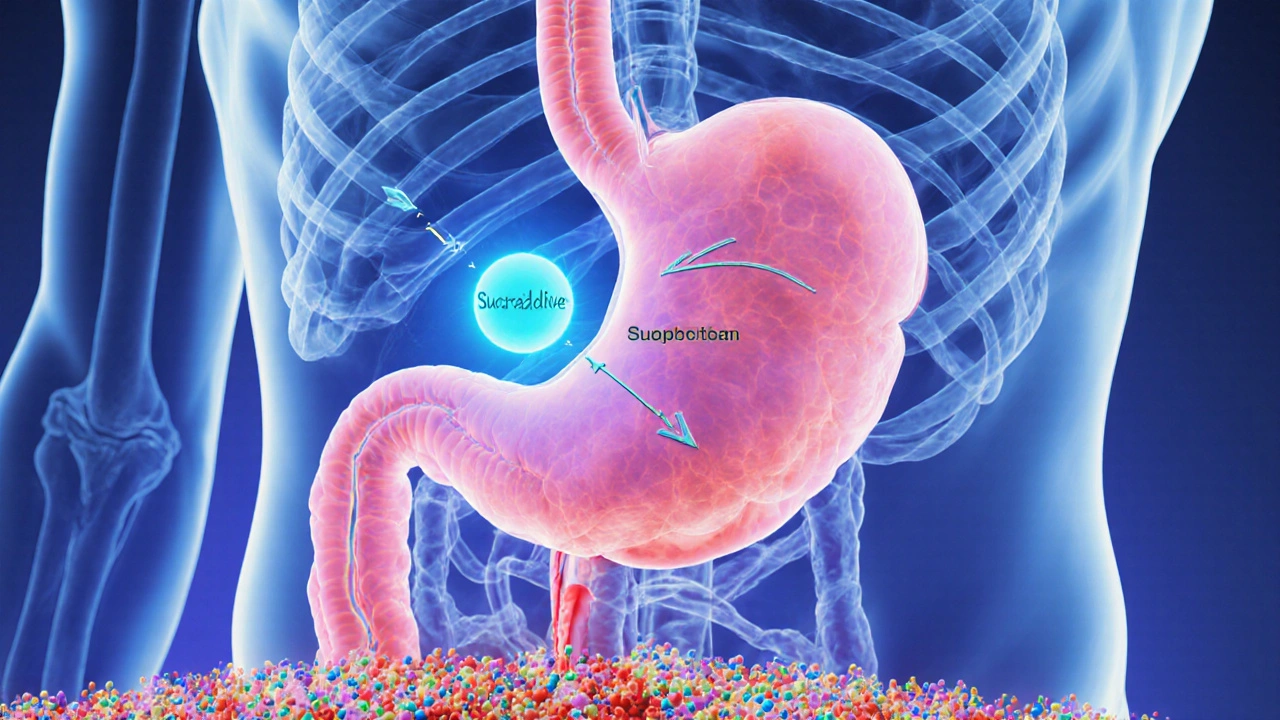
How Stomach Acid and GERD Work
Acid indigestion, medically called gastro‑esophageal reflux disease (GERD), occurs when stomach acid repeatedly backs up into the esophagus. The LES, a ring of muscle at the top of the stomach, normally stays tight to keep acid down. When it relaxes inappropriately, acid can escape, causing a burning sensation, sour taste, and sometimes coughing.
The acidity of the stomach comes primarily from hydrochloric acid, which has a pH of 1‑2. Even a small amount leaking into the esophagus can irritate the lining because the esophagus isn’t designed to handle such low pH. Lifestyle triggers-heavy meals, caffeine, alcohol, and certain foods-are well‑known. Emerging research now points to some non‑nutritive sweeteners as another hidden trigger.
Mechanisms Linking Sweeteners to Acid Indigestion
Scientists have proposed three main ways artificial sweeteners might provoke GERD symptoms:
- LES relaxation: Certain sweeteners stimulate the release of gastrin, a hormone that can cause the LES to relax. A 2022 study on healthy volunteers showed a measurable drop in LES pressure after consuming a sucralose‑sweetened beverage.
- Changes to gut microbiota: Non‑nutritive sweeteners alter the composition of the gut microbiome. Dysbiosis can increase gastric emptying time, leading to more stomach content pressing against the LES.
- Increased gastric acidity: Some sweeteners, especially those that are acidic themselves (e.g., saccharin), can lower the pH of the stomach contents, making any reflux more irritating.
While the exact cause‑and‑effect chain is still being mapped, the clinical evidence is strong enough to merit caution, especially for people already prone to heartburn.
Sweetener‑by‑Sweetener Impact
Below is a quick reference that compares the most common artificial sweeteners you’ll find on label lists. The data pulls from peer‑reviewed trials, FDA dosing limits, and typical usage patterns in Australian food products.
| Sweetener | Sweetness vs Sugar | Calorie Content (per gram) | Typical pH Impact | Evidence of GERD Trigger | Common Uses |
|---|---|---|---|---|---|
| Aspartame | ≈200× | 4 kcal (but used in micro‑grams) | Neutral to slightly acidic | Moderate - multiple case‑control studies link high‑dose aspartame drinks to increased heartburn frequency. | Diet sodas, sugar‑free gum, tabletop sweeteners. |
| Sucralose | ≈600× | 0 kcal | Neutral | Strong - 2022 clinical trial shows LES pressure drop of 10% after a single 12‑mg dose. | Baked goods, bottled teas, protein powders. |
| Saccharin | ≈300× | 0 kcal | Acidic (pH ~5) | Weak - limited data, but its acidity can exacerbate existing reflux. | Tablets, diet beverages, canned fruits. |
| Stevia | ≈250-300× | 0 kcal | Neutral | Low - most human trials report no change in LES tone or gastric pH. | Natural‑sweetener blends, tabletop drops, flavored waters. |
Notice how the sweeteners that are chemically neutral (sucralose, aspartame) still show a clear physiological effect, while stevia, which is derived from a plant, appears benign for most reflux sufferers.
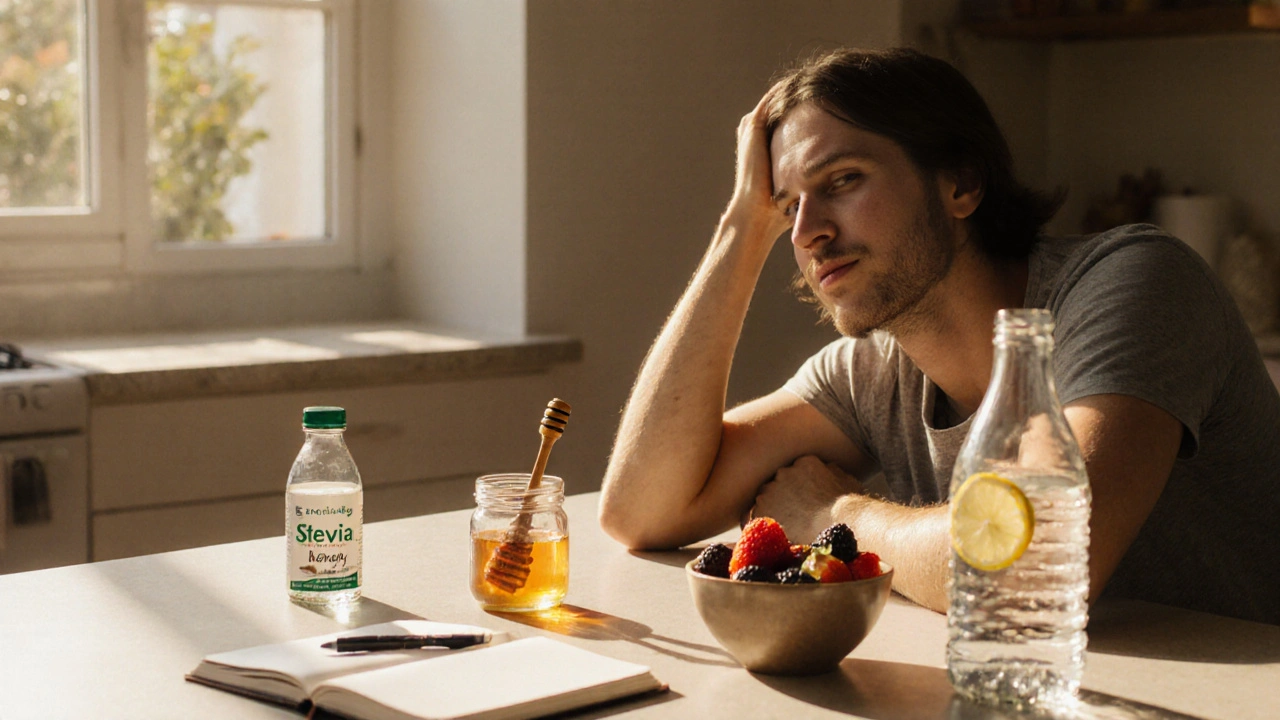
Practical Tips to Manage Symptoms
If you can’t give up that sugar‑free soda or low‑calorie yogurt, try these evidence‑based adjustments:
- Watch portion timing: Avoid sweetened drinks within two hours of bedtime. The supine position makes reflux more likely.
- Pair with protein or fat: Consuming a small handful of nuts or a piece of cheese with a sweetened beverage can slow gastric emptying, reducing pressure on the LES.
- Dilute: Mix diet soda with sparkling water. Lowering the concentration cuts the total sweetener dose.
- Choose low‑impact options: Switch from aspartame or sucralose to stevia or monk fruit extracts when possible.
- Stay upright after meals: A 30‑minute walk helps keep acid where it belongs.
- Monitor your own trigger list: Keep a simple diary noting the type of sweetener, amount, and any heartburn episodes. Patterns emerge quickly.
Alternatives and When to Seek Help
For chronic GERD, dietary tweaks alone might not be enough. Here’s a quick decision guide:
- Mild, occasional symptoms: Adjust sweetener type and timing as outlined above.
- Frequent heartburn (≥3 times a week): Reduce overall sweetener load, consider a short trial of a proton‑pump inhibitor (PPI) under doctor supervision, and schedule a gastroenterology appointment.
- Severe or worsening pain, weight loss, or difficulty swallowing: Seek immediate medical evaluation; these could signal esophageal damage.
In many cases, swapping to natural sweeteners like raw honey (used sparingly) or fruit purées can satisfy cravings without triggering reflux. Remember, “natural” doesn’t automatically equal “low‑calorie,” so weigh the sugar load against the acid risk.
Frequently Asked Questions
Can diet soda really cause heartburn?
Yes. The carbon dioxide in soda increases stomach pressure, and many diet sodas contain sucralose or aspartame, which have been shown to relax the LES and make reflux more likely.
Is stevia safe for someone with GERD?
Current research suggests stevia has little to no effect on LES pressure or stomach acidity, making it one of the safest sweetener choices for reflux sufferers.
How much artificial sweetener is too much?
Regulatory agencies set an Acceptable Daily Intake (ADI). For aspartame, the ADI is 40mg/kg body weight in Australia. For a 70kg adult, that’s about 2.8g, roughly the amount in 20-30 cans of diet soda. Staying well below the ADI reduces the risk of any side‑effects, including reflux.
Do artificial sweeteners affect the gut microbiome?
Multiple animal and human studies show that high‑dose sucralose or saccharin can decrease beneficial bacteria like Bifidobacterium, which may indirectly worsen GERD symptoms by slowing gastric emptying.
Should I stop using all artificial sweeteners?
If you’re prone to acid indigestion, cutting back on aspartame and sucralose is a good first step. Switching to stevia or reducing overall sweetener consumption often alleviates symptoms without sacrificing taste.
Bottom line: artificial sweeteners aren’t the enemy of every diet, but they can be a hidden trigger for acid indigestion. By choosing the right sweetener, timing your intake, and watching portion sizes, you can keep the burn under control while still enjoying a sweet taste.

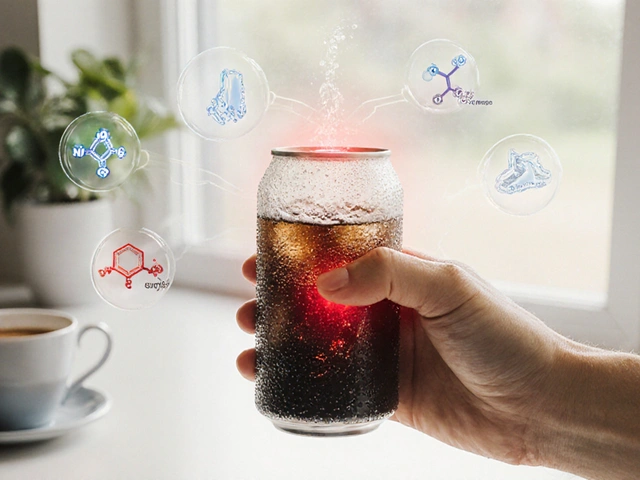
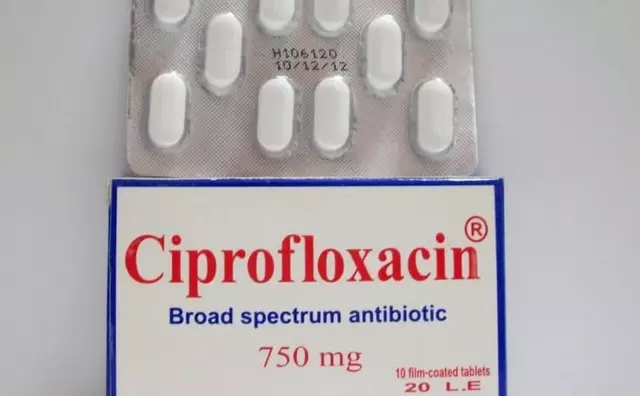


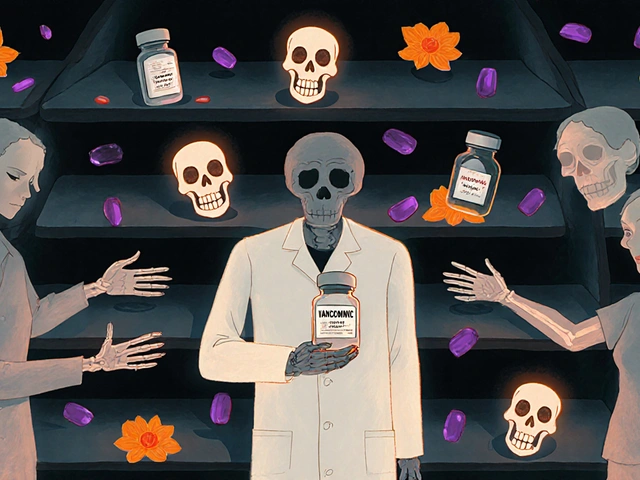

Honestly, I dived into the data on artificial sweeteners and the gut microbiome and I’ve got to say, it’s kinda wild how something so sweet can mess with your LES like that. The article nails the part about sucralose dropping LES pressure, and I’ve actually noticed that after a couple of diet sodas I felt a real burn later on. My own experiment? I swapped out aspartame for stevia for a week and the nightly heartburn totally vanished, which lines up with the low‑risk claim. Also, the timing tip – avoid sweeteners right before bed – makes perfect sense because lying down gives acid a shortcut to the esophagus. I also love the suggestion to pair a sweetened drink with a handful of nuts; the protein really does seem to slow gastric emptying.
The mechanistic pathways outlined are accurate: artificial sweeteners such as sucralose have been shown to elicit gastrin release, which can transiently reduce lower esophageal sphincter tone. Moreover, epidemiological studies consistently demonstrate a dose‑response relationship between high‑intake sucralose and increased GERD symptomatology. It is also worth noting that while the Acceptable Daily Intake (ADI) provides a safety margin, individual susceptibility varies due to genetic polymorphisms in sweet taste receptors. Therefore, personalized monitoring, as suggested, is prudent for patients with refractory reflux.
Building on the previous point, it’s essential to appreciate that the gut microbiota modulation by non‑nutritive sweeteners can have downstream effects on gastrointestinal motility, which in turn influences reflux patterns. The literature indicates that chronic consumption of saccharin and sucralose can decrease Bifidobacterium populations, potentially leading to slower gastric emptying and increased intragastric pressure. This physiological cascade aligns with the observed higher incidence of heartburn among regular diet‑soda drinkers. Additionally, the article’s recommendation to dilute sweeteners with sparkling water is a practical strategy that reduces overall exposure without sacrificing taste.
I totally get why many of us reach for diet drinks – they’re convenient and low‑calorie – but the trade‑off with reflux is real. The suggestion to combine a sweetened beverage with a small source of protein, like cheese or nuts, is something I’ve tried and it noticeably eases the post‑meal burn. Also, the timing advice – no sweeteners within two hours of bedtime – has helped my own night‑time symptoms. It’s not just about swapping sweeteners, but also about how we integrate them into our meals. Thanks for the practical tips!
Look, if you’re still chugging those diet sodas after reading this, you’re ignoring the evidence. Sucralose has a strong link to LES pressure drop, and the data isn’t some flimsy anecdote – it’s a 2022 clinical trial. Switch to stevia or, better yet, ditch the artificial sweeteners entirely. You’ll save your gut and stop the constant heartburn that’s ruining your sleep. Stop making excuses and change your habit now.
Seriously? 🤔 That’s just basic science, no need to act like it’s a groundbreaking revelation. 😏
Americans need to stop importing cheap junk.